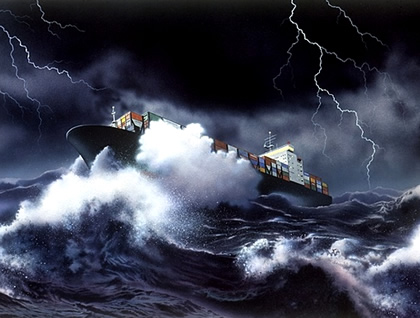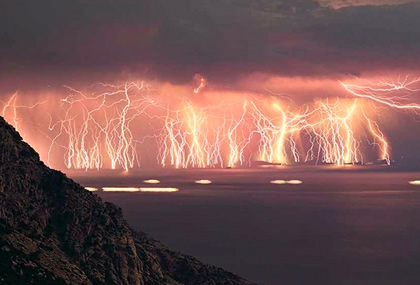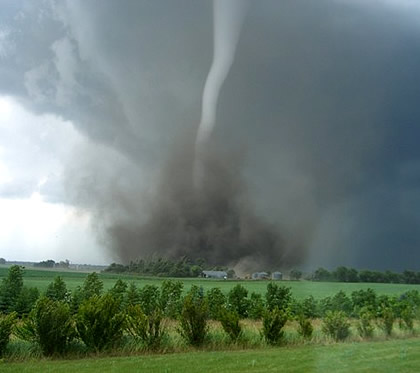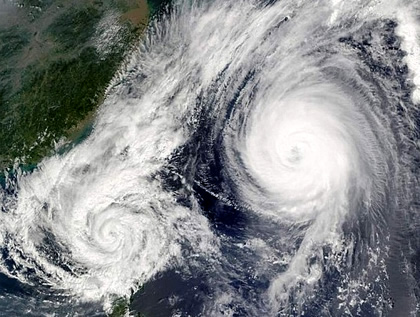 |
| Storm |
Storms are disturbances in the atmosphere (air surrounding Earth) that bring severe weather: heavy rain and snow, high winds, lightning and thunder, tornadoes, and hail.
There are storms that are mild, such as rainstorms, which are beneficial, bringing needed rainfall for plants, animals, and waterways. Yet storms also have the potential to cause great harm. Hurricanes batter coastlines and islands with high winds, drenching rain, and waves.
Thunderstorms and blizzards can cause floods and dangerous traveling conditions. During thunderstorms, lightning can ignite brush fires, and hail can destroy crops. Tornadoes can cut swaths of destruction across anything in its path.
  |
Storms occur in unstable or changing areas of the atmosphere where warm, light air rises rapidly from the land surface. The general conditions that spawn storms are well known; hot summer days in the American Midwest almost always produce thunderstorms.
Cold air low pressure areas cause blizzards in the winter, which sweep eastward and warm seas feeding tropical low pressure systems cause hurricanes that spin from the tropical Atlantic Ocean from June through November. Predicting the exact location, severity, and timing of storms, however, is very difficult.
Although weather forecasting and storm warning systems have become more accurate in recent years, severe weather still takes humans by surprise. Storms cause billions of dollars of damage and kill thousands of people each year around the world.
Thunderstorms
 |
| Thunderstorms |
Thunderstorms form where plumes or masses of warm, moist air rise into cool air above. In temperate climates like central North America, thunderstorms are most common during the spring and summer, but they can also form in the winter.
Temperature differences between rising areas of warm air and cool air surrounding them create air currents (moving stream of air) called updrafts and downdrafts.
Vertically (upwards and downwards) circulating thunderstorm clouds have central updrafts (areas of rising air) surrounded by a ring of downdrafts (areas of falling air). Tall, billowing, black clouds form, called cumulonimbus clouds or thunderheads.
Heavy rain falls. Moving water and ice particles within the clouds create electrical charges, causing lightning bolts to zap between clouds and the ground. Thunder booms and crackles. Thunder is the sound created by the electrical discharge of lightning.
Three ingredients are a recipe for a thunderstorm: warm, moist air near the land surface; cool, dry air above; and something to lift the warm air. Mountain ranges, moving weather fronts (a line between two air masses with differing characteristics, bringing changing weather), converging winds, and uneven heating of land and sea surfaces can all provide an upward push. Sometimes, the rising air is fairly dry, and clouds form that produce lightning but no rain.
A line of thunderstorms can form along the moving front of an air mass. In the summertime, thunderstorms roll across the American Great Plains each afternoon as the land surface heats unevenly. Afternoon lightning and cloudbursts are very common in the Rocky Mountains when warm, moist air rises up the face of the mountain.
Most thunderstorms are short-lived, single cell (brief, small) and multi-cell storms (storms with multiple storm-producing clouds) that may produce lightning and heavy rain, but rarely cause severe damage. The most intense thunderstorms, called supercells, will produce battering hail, flash floods, high winds, and tornadoes.
Tornadoes
 |
| Tornado |
Tornadoes, or twisters, are narrow columns of violently spinning air that extend, finger-like, from the bases of cumulonimbus clouds during intense supercell thunderstorms. Tornadoes form when instability within the storm causes spiraling air circulation.
The base of the storm cloud lowers, and becomes a spinning cloud called a wall cloud. Wall clouds can sometimes develops protruding lumps called mammatus clouds. Tornadoes are whirlpools of upward-moving air that descend from the parent wall cloud to the ground.
The portion of a tornado that actually touches the ground is usually quite small. Numerous accounts describe twisters that completely destroy a structure while leaving an immediate neighbor’s property untouched.
Small whirlwinds like dust devils (small, circular, brief winds on land) and some waterspouts (a column of rotating air, similar to a tornado, over a body of water) can also develop away from a parent thunderstorm.
Meteorologists (weather scientists) classify tornadoes as weak, strong, or violent. Weak and strong tornadoes spin less than about 200 miles per hour (322 kilometers per hour). They can knock over trees, pick up objects and fling them like missiles, demolish mobile homes, and tear roofs from framed houses.
Violent tornadoes can completely destroy a well built home or lift a large object like a car. Thankfully, these are quite rare; only two twisters out of every hundred have winds that exceed 200 miles per hour (322 kilometers per hour).
A tornado like the one that tore Dorothy’s house from the ground and lifted it into the air during a dream in L. Frank Baum’s story The Wizard of Oz is thus unlikely, but not impossible. Dorothy’s home, Kansas, is at the center of “Tornado Alley,” where severe thunderstorms spawn tornadoes that rake across the plains between the Rockies and Appalachian mountains during the spring and summer.
Tropical cyclones
 |
| Tropical cyclones |
Tropical cyclones are huge, spiral-shaped storm systems that form near the equator in the Atlantic, Pacific, and Indian Oceans. Warm, tropical waters fuel their growth from groups of individual thunderstorms, into massive, organized systems of circulating winds and clouds.
Tropical cyclones in the Atlantic and eastern Pacific Ocean are called hurricanes. Western Pacific cyclones are called typhoons, and those in southern Pacific and Indian Oceans are simply called cyclones.
Earth’s rotation causes winds to blow hurricanes and typhoons in the Northern Hemisphere to spin counter-clockwise (east to west). In the southern hemisphere, winds move west to east, causing hurricanes and cyclones to spin clockwise.
Atlantic hurricanes originate from a near-permanent band of thunderstorms near the equator. Warm water and converging trade winds (surface winds blowing westward in the tropics and sub-tropics) create updrafts of moist air that feed huge thunderstorms and dense rain clouds.
The first stage of a developing hurricane, called a tropical depression, forms when a group of thunderstorms organizes around a particularly large storm and begins to rotate.
Some, but not all, tropical depressions grow into tropical storms and then into hurricanes. Tropical storms have more organized spiral patterns and stronger winds than tropical depressions. Although tropical storms are not as powerful as full-fledged hurricanes, they bring very heavy rainfall and often cause severe flooding.
Tropical storms officially become hurricanes when its winds exceed 74 miles per hour (119 kilometers per hour). A small area of calm, called the eye, forms at the center of the storm. The eye wall, a ring of intense winds and heavy rain, surrounds the eye.
Bands of rain and clouds spiral out to the edges of the storm. Meteorologists rate hurricane intensities from category 1 to category 5. Hurricanes stronger than category 3 (wind speeds greater than 111 miles per hour or 179 kilometers per hour) generally cause extensive damage when they make landfall.
Atlantic tropical storms and hurricanes ride the warm Gulf Stream current (a warm northbound surface current that carries Atlantic Ocean water into the Norwegian Sea) northwest from the tropics toward the Caribbean Sea, Gulf of Mexico, and Atlantic coast of the United State.
Tropical cyclones depend on warm ocean water to feed warm, moist air into their central updrafts, so they fade when they move over cool water or land. Tropical cyclones take several weeks to develop and move across the ocean before subsiding, and there may be several storms in a particular ocean at one time.
To avoid confusion, meteorologists assign names to tropical storms and hurricanes using alphabetical lists of alternating male and female names. The first storm of the year has a name starting with A, the second with B, and so on. (There are no names beginning with Q, U, or Z.)
The 2004 list for the Atlantic Ocean included such early-in-the-alphabet names as Charley, Frances, and Ivan. There are six lists, so these names will be used again in 2010. The names of very large and destructive hurricanes like Camille (1969), Hugo (1989), and Andrew (1992) are retired from the list.
Mid-latitude cyclones
Mid-latitude (areas midway between the equator and the poles) cyclones cause most of North America’s stormy weather. Like tropical cyclones, mid-latitude cyclones are low-pressure systems that rotate counterclockwise in the Northern Hemisphere. Westerly (east-blowing) winds drive air masses across North America from west to east. Easterlies blow cold air to the west in northern Canada.
Mid-latitude cyclones develop when a cool, dry air mass follows a warm, moist one. (The leading edge of the cool air mass is called a cold front.) Some of the warm air flows north (left) toward Canada, and some of the cold Canadian air blows south (left) creating a counter-clock-wise spiral with rising air, and low pressure, at its center.
Storms form along the cold front and in the low pressure zone where warmer, moist air is forced up into the overlying cold air. Warm air moving north from the Gulf of Mexico provides moisture to fuel winter blizzards and summer thunderstorms in Great Plains. Cyclones also draw moisture from the Great Lakes and drop heavy rain and snow downwind to the east.
When a large cyclone reaches the northeast coast of North America, the spiraling winds extend over the North Atlantic and pick up more moisture and then blow back toward the continent. Nor’easters are cold, wet storms that blow into Maine, Nova Scotia, New Brunswick, and Newfoundland from the northeast.